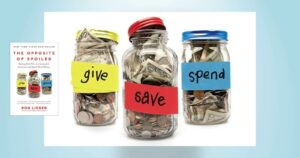As parents we want to make sure that we’re getting our children ready for the world, almost as soon as they’re born. Financial savvy is somewhere right at the top of that list.
The good thing is, kids do begin to learn very early on. So we can begin to teach them the principles of financial awareness even before they’re ready for Kindergarten. Here’s how to teach your preschooler about money:
#1 Habits of the Mind
Children can be taught, very early on, to cultivate mental processes that focus on self awareness and self-regulation and inculcate effective problem-solving techniques- to help them deal with the curve balls that life throws at us everyday.
Most of financial savvy is, after all, self-regulation.
A good investor is not the one who knows a bunch of intricate things that no one else does. A good investor is one who can stay the course when the going gets tough.
Developmental neuroscientists believe that’s by 4-5 years of life, kid brains have developed enough that they can process the thinking, reasoning and the learning needed to grasp the basics of financial behaviors.
All we need to do is expose them to new experiences in safe and warm learning environments. Take them along for the ride when you go about your usual day- errands or the bank. Or make your phone calls to the mortgage company or credit card company in their presence. They soak it all up.
#2 Imitation
Children do as we do, not as we say. They learn by imitating us- from speech and mannerisms to thought processes and world views.
Recent evidence suggests this is due to”mirror neuron” systems. These neurons fire both when we observe someone in front of us feeling a certain way as well as when we are feeling the same way. This is what helps us understand how the person in front of us is feeling and where they’re coming from.
We use this to teach our children good financial principles by modeling those very things.
They notice when we restrain ourselves at the store from an impulse buy. Maybe say, “It is not that we can’t afford it, it’s just that we don’t need it”. Invoke some Marie Kondo if that’s your thing.
Let them see you drive a modest car or live in a modest house. Let them learn that “you have what you don’t spend” from your life.
But all things in moderation! Celebrate your wins, create memories and cultivate friendships. Let the kids see how money is a tool that can enrich your lives.
#3 Inductive Learning
This is the kind of learning that relies on patterns and regularities in everyday experiences. Language is a good example that uses inductive learning, which is why it comes so easy to young kids.
Inductive learning is the reason why kids learn so much better from experience than learning from instruction.
Once children have grasped a pattern, they can apply it to new but related experience. This is how they can both reflect on the past and plan for the future.
Kids will grasp many “basics” of financial principles through this mode- the give and take of purchases, the denominational value of money, how work brings in wages, and a host of other everyday observations.
#4 Self regulated learning
Learning environments where experiences are challenging and autonomous, foster children’s self-regulation and motivate them. When kids get to choose the level of challenge in learning, they seek out more of it. This must be accompanied by a “mastery-oriented” approach- that I can get better at something by putting effort into it.
This turns challenges into stepping-stones towards competence and mistakes into opportunities to do better.
Whenever possible, making sure they’re out of harm’s way, let them figure it out on their own.
#5 The role of Media
Children under the age of 8 years do not differentiate between needs and wants and do not yet associate material possessions with social standing. But this rapidly changes the more they are exposed to media advertising.
Kids often begin to get the message that worldly possessions are a basis for self-worth. This is when parents need to step in. Each family will do it differently, but the basic premise is that something needs to be more important to strive for, than money.
Young children also do not initially understand that the purpose of advertising is to get us to buy stuff. How they subtly and not-so-subtly influence our behaviors. Parents may want to point this out.
My daughter was obsessed with a very successful kid Youtube channel that reviewed toys. She really thought he was genuinely sharing information about his toys. She was almost offended when I pointed out to her that the kid in the channel got paid to talk about the toys.
#7 Social Learning
We are social beings, right from the get go. Positive social interactions are a huge motivations for children. And therefore create great teachable moments.
Young kids want to accompany you to the store or the bank- they enjoy your company and it feels very “grownup” to participate in this ritual. That is their motivation to learn about it.
They look forward to “pocket money”- not only because it gets them candy- but because it fosters conversation and the encouragement of an adult who matters to them.
#8 Executive Functions
These functions appear only about age 5 and take time to mature. They are critical for two important financial goals: planning and delayed gratification.
And I do not need to preach to choir the importance of these twin pillars of financial stability.
Teaching Preschoolers about Money
Here are some concrete steps you can take to teach them some basics of money:
- Count. A lot. Everything around you.
- Compare objects, one characteristic at a time. It teaches them concepts of more/less, bigger/smaller, etc.
- (Coin) size doesn’t matter. Value does. This takes some time to grasp, but the value of money is not always proportionate to its size. Similarly, with paper money, more in number doesn’t always equate to more value.
- Buying is a give and take. To illustrate the transactional nature of a purchase, take kids shopping and let them see you pay in return for goods.
- Teach kids the denominational value of money. Not all denominations will be enough to purchase something.
- Children need to understand that they need to give up money in order to get something. That it’s gone for good and doesn’t come back. And to get more of the desired object, they need to spend more money.
- The concept of “change”- when the sum of money paid is more than the value of good purchased.
- The concept of “representation”: when credit/debit cards are used, they represent money.
- The concept that work brings in wages. And that different kinds of work earns different amounts of wages.
- Involve the kids in making a shopping list and sticking to it.
- Compare prices of objects in the store and talk about how you decide which one to get. Explain why you may choose the more expensive product if quality is important, or a health concern- such as organic produce. Talk about why the “branded” product is not always worth ponying up for.
- The concept that we cannot afford everything. And that it’s okay. This discussion can even segway into inequalities and fairness on a societal or global scale.
- The concept of time. This is very abstract for young ones to grasp. Some examples that may help are activities from their own lives. If they can have something in a week, that’s seven “wakeups”. A month can be four weekend playground visits. Longer wait times can be correlated with birthdays or holidays.
- To help with waiting, two things help: (1) distraction. Everyone knows about the marshmallow experiment. In it, the kids who found it easiest to wait were those who were best at distracting themselves. Not thinking about the most desirable aspects of the object you’re waiting for is a good idea. (2) Doing something concrete to help with waiting. Such as coloring in a “savings” chart when waiting to buy something. Google has many creative printables- pick any you like.

- Involve children in the decision-making process regarding saving/waiting for something they want. This makes it more palatable and ultimately more successful.
In essence, with young kids, talking about money may not be the most important thing. Creating an environment to foster well-rounded development, including emotional stability and self-regulation will ultimately give them the tools to be financially successful.
What do you think? What has worked for you with your children? share your ideas here.




